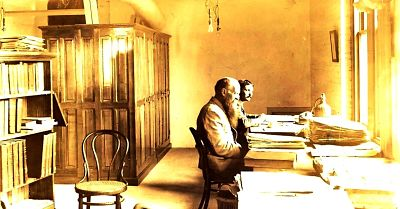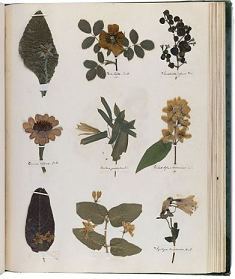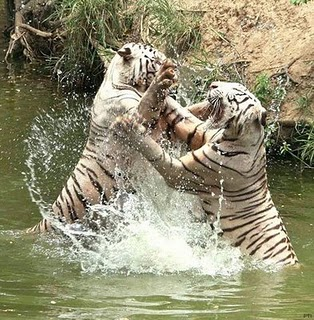Taxonomical Aids (Tools for Study of Taxonomy)
Table of Content |
 Techniques, Procedures and Stored Information that are useful in Identification and classification of organisms are called taxonomic aids.They are required because taxonomic study of plants, animals and other organisms are basic to almost all branches of biological studies for their proper identification and finding their relationships with others. Herbarium, botanical gardens, museum, zoological parks (zoos) and key are important tools used in identification of plants and animals.
Techniques, Procedures and Stored Information that are useful in Identification and classification of organisms are called taxonomic aids.They are required because taxonomic study of plants, animals and other organisms are basic to almost all branches of biological studies for their proper identification and finding their relationships with others. Herbarium, botanical gardens, museum, zoological parks (zoos) and key are important tools used in identification of plants and animals.
Herbarium
 Herbarium is a place where dried and pressed plants specimens, mounted on sheets are kept systematically according to a widely accepted system of classification. Herbarium is a repository or store house for future use. Every institute teaching botany, school college or university, has a small or large herbarium. Very large herbaria are maintained by botanical gardens and institutes connected with plant systematic.
Herbarium is a place where dried and pressed plants specimens, mounted on sheets are kept systematically according to a widely accepted system of classification. Herbarium is a repository or store house for future use. Every institute teaching botany, school college or university, has a small or large herbarium. Very large herbaria are maintained by botanical gardens and institutes connected with plant systematic.
Every student of botany is required to collect plant specimens and prepare herbarium sheets.
Equipment: Digger and pruning knife, sickle with long handle, vasculum, polythene bags, magazines or newspapers, bolting papers, plant press, field notebook, herbarium sheets, glue, labels, small transparent polythene bags.
Specimen (Herbarium Sheet) is of Different Types
 Holotype: Herbarium sheet on which the first description of plant is based.
Holotype: Herbarium sheet on which the first description of plant is based.- Lectotype: In case of holotype is lost, second herbarium sheet prepared from the original plant is called lectotype.
- Neotype: In case holotype and original plant is lost then herbarium sheet prepared from some other plant of same
- Syntype: In case holotype and original, plant is lost then many herbarium sheet prepared from many plants of same species is called syntype.
- Isotype: Duplicate of holotype - In presence of holotype a second herbarium sheet prepared from the original plant is called isotype.
- Paratype: Additional herbarium sheet used in the first description of plant is called para type. It is prepared from some other plant of same species having some variations.
Method of Specimen Collection and Mounting
 An area is selected for botanical excursion. It is preferable to visit the same site in different seasons. For herbaceous species the entire plant with intact part is collected. for others, shoots having flowers, leaves and fruits are selected and cut with the help of pruning knife. Sickle with long handle is used if the desired twigs are present at a height. Diggers are used to obtain underground part like root system, tuber, bulb, corm, rhizome, etc. The collected material can be placed in polythene bags or vacuum.
An area is selected for botanical excursion. It is preferable to visit the same site in different seasons. For herbaceous species the entire plant with intact part is collected. for others, shoots having flowers, leaves and fruits are selected and cut with the help of pruning knife. Sickle with long handle is used if the desired twigs are present at a height. Diggers are used to obtain underground part like root system, tuber, bulb, corm, rhizome, etc. The collected material can be placed in polythene bags or vacuum.
Important Herbaria
|
Name |
Number of Herbarium Specimens |
|
Royal Botanical Gardens, Kew (London)(largest herbarium) |
6.5 million |
|
Museum of natural history (Paris) |
Over 6.0 million |
|
Conservatories at jardin botanical institute de Geneve (Geneva) |
over 5.0 million |
|
V.L. Komarov Botanical Institute of Azerbaijan |
4.0million |
|
New York botanical Garden (New York) |
4.0 million |
|
Central national herbarium (India) |
|
|
Madras herbarium, Coimbatore (MH), India |
1,50,000 |
|
Herbarium of National Botanical Research Institute, Lucknow, India |
80,000 |
Botanical Gardens
 Botanical gardens efficiently large size tract where plants of different type and areas of grown for scientific and educational puposes . The first real mechanical garden was developed by Theophrastus (370-285 B.C.). Of course, garden was part of Indian Chinese and roman cultures. “Hanging Garden” of Babylon were considered to be wonders of ancient time. Modern day Botanical Gardens contains beside outdoor plants, greenhouse, library, research laboratory herbarium with documented collections of various taxa. There is an international association of botanical gardens (established in 1962) which coordinate research and exchange of plant materials.
Botanical gardens efficiently large size tract where plants of different type and areas of grown for scientific and educational puposes . The first real mechanical garden was developed by Theophrastus (370-285 B.C.). Of course, garden was part of Indian Chinese and roman cultures. “Hanging Garden” of Babylon were considered to be wonders of ancient time. Modern day Botanical Gardens contains beside outdoor plants, greenhouse, library, research laboratory herbarium with documented collections of various taxa. There is an international association of botanical gardens (established in 1962) which coordinate research and exchange of plant materials.
The important functions of botanical gardens are:
(i) Growing important plants of local flora.
(ii) Keeping record of local flora.
(iii) Providing living plant material for systematic work.
(iv) Supplying seeds and materials for different aspect of a Botanical research.
(v) Growing and maintaining rare and endangered plant.
Museum
 The word museum comes from the greek word mouseion. In ancient Greek mouseion was the temple of Muses. the goddess of arts and sciences. Museum is an institution where artistic and educational materials are exhibited to the public. the materials available in exhibition for study in called collections. A Collection may include scientific specimen, works of art and exhibits and information on history of technology.
The word museum comes from the greek word mouseion. In ancient Greek mouseion was the temple of Muses. the goddess of arts and sciences. Museum is an institution where artistic and educational materials are exhibited to the public. the materials available in exhibition for study in called collections. A Collection may include scientific specimen, works of art and exhibits and information on history of technology.
There are five main kind of museums namely art museum, history museums, applied science museums, natural science museums and general museums.
Function of Museums
 Museums Performs the following functions:
Museums Performs the following functions:
-
Acquisition of materials. Every new object that a museum adds to its collection is called Acquisition. Museum acquire object in several ways, of which field collection is one of the most useful. The scientific and technician go outside to gather specimens and data on particular subject which is with the scope of the museum.
-
Recording of Materials. Each acquisition is listed carefully by specialist staff. As soon as objects are received, the data, the source, the method of acquisition and other available information are entered in to record register.
-
Preservation of Materials. The primary purpose of museum is to preserve selected objects are received. Curators (person in charge of museum) know that no specimens will last forever. What museums undertake to do is to prolong the lifetime of the objects. Preservation in a museum consists of two steps:
(i) Specimens must be put into a condition that that checks deterioration.
(ii) The specimens must be protected.
-
Research: One important use of museum is to extract as much knowledge as possible specimens. Many museums published scholarly journals, series of papers and books to make available result of research on collections.
-
Exhibitions of Materials: Various members of museum staff prepare acquisitions for exhibitions. The specimens selected for exhibition are put on a view in numerous ways. The choice of approach and techniques depends on the purpose of exhibits.
-
Education. A Number of universities conduct some courses in certain subjects as museum university advantage of the collections. Thus museums help in spreading education.
Zoological Parks (Zoos)
 A Zoo is a place where are various living animals are kept within enclosures display to the public and may be used for study. Animals may also Bred.
A Zoo is a place where are various living animals are kept within enclosures display to the public and may be used for study. Animals may also Bred.
In fact concept of ZOO has changed instead of Zoos, Zoological parks or zoological gardens established where high standard of care is observed and the animal live under more natural conditions.
The animal provides better recreation to the visitors.
Nehru Zoological Park (also known as Hyderabad Zoo or Zoo Park) is a zoo located near Mir Alam Tank in Hyderabad, Telangana, India.
The Role of Zoological Parks In Wildlife Conservation
The regular zoo movement in India began in the year 1885 when the first zoo was set up in Chennai. In the Zoological park animals enjoy protection, fine sun shine, fresh air and above all ample open space to play about. They have now become repositories of threatened wild life and a store house of the knowledge on animal behavior, their breeding habit, etc. zoological park is the place where they are assured of food, medical care and treatment and where they also feel safe from their natural enemies. Zoological Parks are very useful in spreading knowledge on the wildlife wealth of the country.


Question 1: The term taxon refers to –
(1) Name of a species
(2) Name of genus
(3) Name of family
(4) A taxonomic group of any rank
Question 2: The herbarium specimen on whose basis a new species is described for the first time is called as
(1) Syntype
(2) Holotype
(3) Paratype
(4) Neotype
Question 3: The standard size of herbarium sheets is –
(1) 11.5" × 16.5"
(2) 15.5" × 16.5"
(3) 18.5" × 10.5"
(4) 20.5" × 21.5"
Question 4: Herbarium is –
(1) A garden where medicinal plants are grown
(2) Garden where herbaceous plants are grown
(3) Dry garden
![]()

|
Q.1 |
Q.2 |
Q.3 |
Q.4 |
|
4 |
2 |
1 |
3 |
Related Resources
-
Get study material on Plant Kingdom here
-
Click here to refer the Useful Books of Biology for NEET (AIPMT)
To read more, Buy study materials of The Living World comprising study notes, revision notes, video lectures, previous year solved questions etc. Also browse for more study materials on Biology here.
View courses by askIITians


Design classes One-on-One in your own way with Top IITians/Medical Professionals
Click Here Know More

Complete Self Study Package designed by Industry Leading Experts
Click Here Know More

Live 1-1 coding classes to unleash the Creator in your Child
Click Here Know More

a Complete All-in-One Study package Fully Loaded inside a Tablet!
Click Here Know MoreAsk a Doubt
Get your questions answered by the expert for free